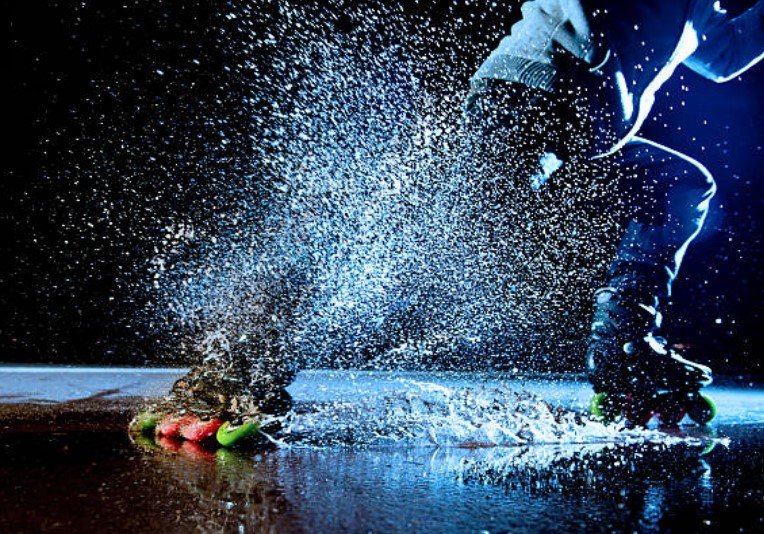

Autumn has been here for a while now, and this time of year I often get the question: is inline skating in the rain even possible?
Yes, it is possible to skate in the rain — even heavy rain. However, your wheels and bearings need special attention.
Most bearings are made of chrome steel, which can rust. If you accidentally roll through a puddle once, you don’t need to worry too much. Usually, they won’t seize up or rust from that. But if you occasionally skate in the rain, you should use stainless steel or (semi-)ceramic bearings.
If you did use chrome steel bearings in the rain, you can still save them by cleaning them immediately after getting home. (And by “cleaning” I don’t mean wiping them down — I mean degreasing and re-lubricating them internally. More on that in a future blog.) Of course, most people don’t feel like cleaning 16 bearings after every rainy ride. And if you use your skates for commuting, it's just not practical.
So for skating in the rain, you’ll need stainless steel or ceramic bearings. But which one is best for you?
Ceramic bearings aren’t just suitable for wet conditions — they’re also the fastest bearings available, even on dry pavement. Inline racing always uses ceramic ball bearings. They’re also low-maintenance. If they do need cleaning, they’re easy to clean with compressed air since they contain little to no lubricant.
However, ceramic bearings do have two downsides. First, they’re significantly more expensive than stainless steel bearings — especially when comparing initial purchase prices. (If you calculate the price per kilometre, it’s not so bad.) Second, they’re not ideal for skaters who like jumping off obstacles. The balls inside the bearing can crack from hard impacts. (To be clear: you can still jump over obstacles if needed. We just mean they’re not the best choice for practicing high-impact tricks like clearing a two-meter ramp.)
Stainless steel bearings, on the other hand, are perfect for sliding, jumping, and generally skating hard. Technically, stainless steel is softer than chrome steel, but in practice you won’t notice much difference. The stainless steel used in rain bearings ensures they don’t rust. Plus, the inner and outer rings are designed with extra steps to keep out dirt and water. They’re also lubricated with a special water-repellent grease.
Many people can use a single set of stainless steel bearings for several years without maintenance. Myself, I don’t just skate in the rain — I often skate in the rain *at night* on unfamiliar, poorly lit roads. I often end up on muddy paths that looked like perfect asphalt in the dark from afar. With that kind of usage, dirt will inevitably get into the bearings. Before I had a skate shop (now I like testing different bearings; so it's another situation), I always made sure to keep two or three spare sets of stainless steel bearings at home. When a few would seize up, I’d just replace them with clean ones from another set. I’d save the dirty ones until I had enough to make it worth cleaning them all at once. They don’t rust, so it’s fine to leave them dirty for a while. (In a future blog, I’ll share how to clean stainless steel bearings.)
Other methods of protecting your bearings from rain don’t work.
For example, online you might find the tip to skate in the rain with regular bearings and then spin them by hand for two minutes at home to "centrifuge" the moisture out. In reality, this doesn’t work — even if you spin them for two hours. Maybe that tip came from someone in California who thinks of rain as warm, gentle droplets nourishing the cacti and palm trees along Venice Beach. I live in Western Europe, and to me, rain means getting home quickly, removing your skates, and putting your soaking clothes in the sink before taking a shower — just to avoid soaking the floor. If you skate in actual rain with regular bearings, they’ll quickly fill with more water than lubricant. Spinning them afterwards won’t magically bring the oil back.
To avoid having to clean bearings, I once tried buying bearings with a closed casing, planning to just throw them out once they seized. That didn’t go well: after (actually, even *during*) the first light rain, 14 out of 16 bearings had already seized and were useless.
In our next blog, we’ll explain which 76, 80, and 84 mm wheels are best suited for rainy weather and why. As a sneak peek: for 76 mm wheels, we recommend the Hyper Concrete wheels. You can find them here. Stainless steel rain bearings can be found here.
The product has been added to your cart.
There are no products left.
The product has been added to your wishlist.
Something went wrong.
The desired quantity of this product is at this moment available. No email will be sent.
No user has been linked yet to this wishlist. For this functionality, please log in, then an email address is linked to this wishlist. If you don't have a login yet, please register. Only an email address is necessary to register/log in. Only at the checkout an address is required!